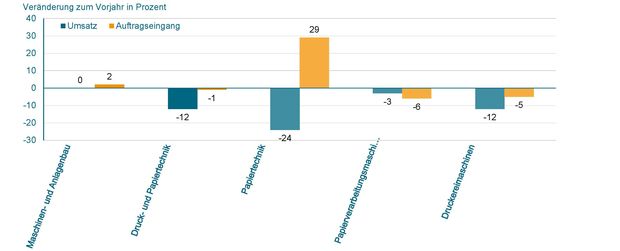 With sales down 12 percent, the situation of the German printing and paper technology industry remained tense in 2014. The calculated order intake was at the level of the previous year; paper technology showed a 29 percent increase, but printing machine sales went down five percent. The order volume for paper converting technology also decreased by six percent.
With sales down 12 percent, the situation of the German printing and paper technology industry remained tense in 2014. The calculated order intake was at the level of the previous year; paper technology showed a 29 percent increase, but printing machine sales went down five percent. The order volume for paper converting technology also decreased by six percent.
"In some cases, the lack of demand requires our member companies to make painful adjustments," says Dr. Markus Heering, Managing Director of the VDMA Printing and Paper Technology Association. In the past year, the situation has dramatically worsened due to decreasing business in China. While printing and paper technology of approx. 641 million Euros was shipped from Germany to China during the first eleven months of the previous year, the export volume in the first eleven months of 2014 dropped to 493 million Euros. "Chinese manufacturers tell us that they, too, have big sales problems in their home market," Heering explains, adding that they increasingly switch to neighbouring countries in South East Asia, which then results in stronger competitive pressure there.
Europe is the most important market – ray of hope in the USA
With the pulling force of the Chinese market diminishing, Europe and the USA increasingly come to the fore for the German suppliers of printing and paper technology. "In 2014, too, Europe remained by far the most important market for our member companies," Heering stresses, making plain that the total of exports to Turkey, France, Poland, Russia, the UK, Italy and Switzerland alone exceeded one billion Euros during the first eleven months of the past year. Amounting to 1.03 billion Euros, they were significantly higher than the total of exports to the two largest single markets of China (493 million €) and the USA (425 million €).
As a result, the export of printing and paper technology to the USA was only approximately 70 million Euros lower than that to China last year. One year earlier, the difference between these markets was still 250 million Euros. For Heering, this is confirmation of the strategy of the German manufacturers: "Despite all the efforts that had to be made in China during recent years, they never neglected their traditional markets." According to him, this also explains why still every third printing machine and every fifth paper converting machine sold worldwide comes from a German manufacturer, although global competition is increasing and there are many new players in the market. The graphic arts industry is changing all over the world, but still chooses technology made in Germany wherever this is possible.
Hope for TTIP agreement
"The growing strength of the US market last year underlines the importance of the transatlantic trade for our industry," Heering stresses. His association and the American Association for Suppliers of Printing, Publishing and Converting Technologies (NPES) therefore support a strong transatlantic free trade agreement TTIP. In Washington in mid-December, they had signed a joint declaration and sent it immediately to the chief negotiators of both economic areas. According to Heering, the portfolios of the German and the US manufacturers of printing and paper technology supplement each other. "While we are above all strong as regards the analogue printing methods, the US colleagues are very strong as regards the digital ones," he explains. A common trade area with harmonized rules will help companies on both sides of the Atlantic.
In view of the difficult market situation in the graphic arts industry, the German manufacturers of printing and paper technology focus their portfolios more strongly on industrial printing and packaging printing. "With their technologies, they are in a position to offer their customers integrated flexible solutions for improved quality and the enhancement of products and packaging means," says Heering, pointing out that they range from laminate printing to finishing technology to print on glass, plastic and metal products. "This re-orientation and further development will also give drupa 2016 a different face," he announces. There, the pioneering technologies that will point the way to the future of the industry will be shown.
www.vdma.org


















































































